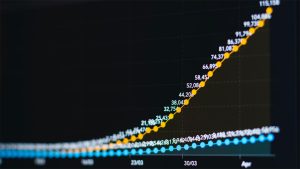Today’s U.S. coronavirus case update is full of good, and bad, news.
First the good. American testing capacity continues to increase, having reached a sustainable level in excess of 300,000 per day. Having being stuck below 200,000 until very recently, it is good to see the United States finally breaking through several bottlenecks.

However, this needs to be kept in perspective. Portugal, one of the EU’s financial bailout cases, has been consistently testing at this level in per capita terms for weeks now. Portugal isn’t the outlier here. That’s the United States, which is in only now reaching a reasonable testing level for being early in the epidemic.
The most important word in that sentence is “early”.
The United States has not crushed its case load in the way the Koreans, Taiwanese, Singaporeans, Chinese, Irish, Australians or Germans have. There are two reasons for this.
First, the American lockdown was not nearly as stringent as most other countries. Most other countries prevented infected individuals from returning home where they might infect their family members. Such family-to-family transmissions in China were responsible for 80% of infections.
Second, the United States entered the epidemic later than other countries, so it enacted lockdowns later and so saw its case loads drop later. Belgium and Italy and France and Spain – the four hardest-hit European states – all entered the epidemic earlier than the United States, and yet the United States is loosening its lockdown earlier than the Europeans.
That means America’s “second wave” of infections will be nothing of the sort, because the “first wave” was never crushed down. The “first wave” will simply have been a step up in caseloads. America’s lockdown only reduced active cases by about one-quarter instead of the 85%+ necessary to truly crush the virus, and so the “second wave” will now begin from an already-elevated case load.
This removes the United States from the list of countries including China and Korea and Germany which have largely removed the virus from their populations, and instead shifts it to a list of countries including Brazil and India and Nigeria where coronavirus is now endemic.
And that changes the path of the pandemic and its impacts on a global scale.
On May 19 I’ll be doing a once around the world, laying out where we stand in the current crisis. Which countries are suffering most critically? Which are pulling ahead? What the shape of the pandemic will be in the weeks and months to come? What will the world look like once coronavirus is in our collective rear-view mirror? As with all the videoconferences, attendees will have the opportunity to submit questions during the event.
While most of these events are for a set fee, the May 19 event will be free of charge. We’ve managed to expand our technical capacity and so still have lots of seats. And should those fill up as well, fear not! We’ll be recording the entire videoconference and posting it upon completion. First release will be via this newsletter list which you can join on the newsletter page.
Newsletters from Zeihan on Geopolitics have always been and always will be free of charge. However, if you enjoy them or find them useful, please consider showing your appreciation via a donation to Feeding America. One of the biggest problems the United States faces at present is food dislocation: pre-COVID, nearly 40% of all foods were not consumed at home. Instead they were destined for places like restaurants and college dorms. Shifting the supply chain to grocery stores takes time and money, but people need food now. Some 23 million students used to be on school lunches, for example. That servicing has evaporated. Feeding America helps bridge the gap between America’s food supply (which remains robust) and its demand (which coronavirus has shifted faster than the supply chains can keep up).
A little goes a very long way. For a single dollar, FA can feed one person for three days.








